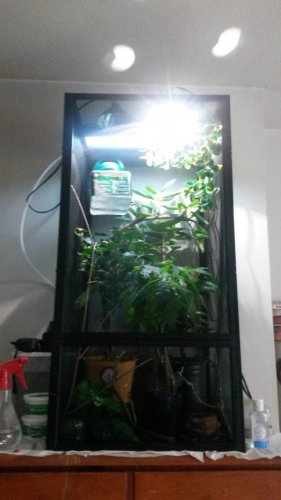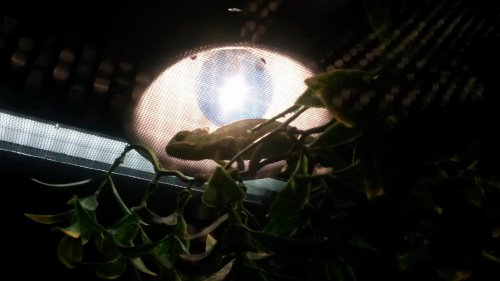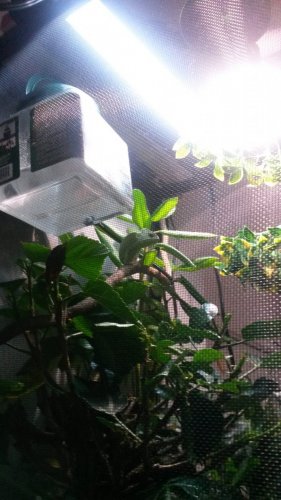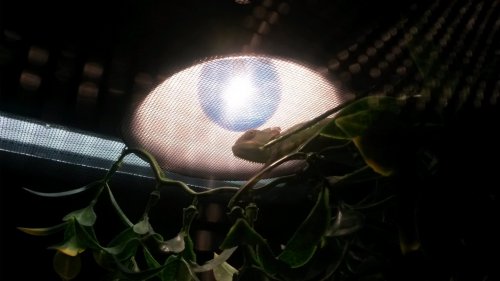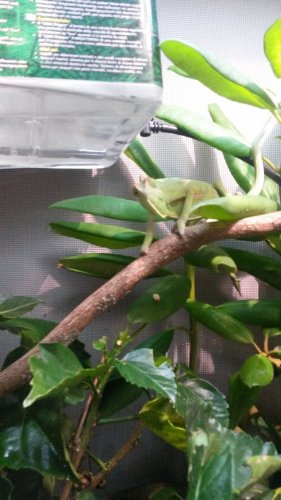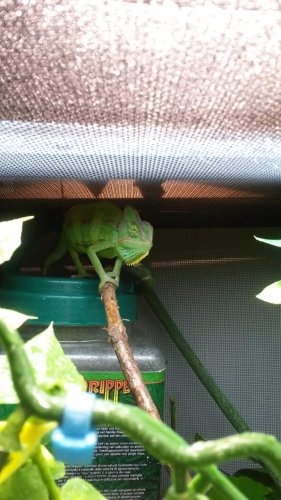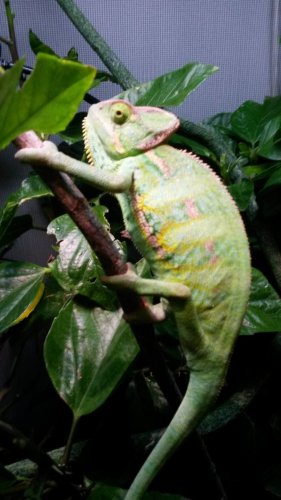kimmytheriault
Member
First, I hope I am posting this is the correct place - if not I apologize in advance and just direct me in the correct place to post this! Second, I tend to be long winded so I am going to try to be as brief as possible while also giving as much information as needed so you guys can help me. Third, to all of the active members here who freely offer advice to those of us (myself included) who are novices (at best!) I thoroughly appreciate what you do. I am welcome to all advice! Freely tell me what I am doing wrong so that I can correct it and make everything RIGHT for this guy - I am NOT one of those who will ask for advice and not take it, or become offended when it is given. So, here's my story/questions. I will bold my questions so those of you who don't wish to read my WHOLE BOOK can just answer my questions. Thanks in advance!! 
Approximately a week ago a childhood friend of mine went into work (she is a Veterinarian who specializes in household pets and has a passion for livestock). Upon pulling in she found a 20 gallon glass tank with substrate, barely any branches, and a veiled chameleon sitting on the edge of a feeding dish. He was truly a sad sight. (My profile picture is actually a picture of this guy when I first laid eyes on him.) Knowing that I often "foster" animals (we recently adopted a kitten with one eye from her) and that I used to own gargoyle & crested geckos (and have SOME LIGHT knowledge of reptiles) she asked me if I could take this guy in. I agreed. He was seen by a reptile specialist/vet from a neighboring town who gave him a clean bill of health, an approximate age range of 5-ish months, and confirmed his sex. And off he came to my house, where we spent the next few days attempting to create an environment for him to thrive in - which lead me all over the internet in a mad dash to understand veiled chameleon husbandry - which is COMPLETELY different than gargoyle geckos (obviously). And, so here I am. Trying like hell to make sure this guy gets exactly what he deserves since the first few months of his life have clearly been stressful - something this guy doesn't deserve!
This is what we have done so far, and I just want confirmation from SOMEONE that we are on the right path OR, if not, steer us that way. We've already fell in love with this little dude (who my daughter quickly named "Custard") and decided this will be his home - he doesn't deserve to be shuffled around, or G-d forbid, discarded on another doorstep. This is where you come in - and that way you can help me save his guy and give him a quality existence!
Enclosure/Humidity?Temperature:
He now has a screened cage (I already forgot the dimensions of it - oops. I'll post pictures though so you can see if the size is appropriate). My husband is a computer programmer who devised a misting apparatus out of an ardunio, tubing, and a tank. It is currently set to mist his enclosure once an hour for approximately 20 seconds - this seems to be getting all of the leaves thoroughly misted (as I know chameleons won't drink from standing water.) Is this misting regimen too often, or not enough? We also have a spray bottle to spray the "cage" in between if it needs it and a "little dripper" which appears to have been a waste of money because I'm convinced it does absolutely nothing. As for Lighting he has a basking bulb that sits directly on the top of the change pretty close from where he sits on a synthetic vine, what should the distant be between the basking lamp and the vine to bask on? Is it possible that he could become burned by this? He then has a UVB Bulb that is situated on the back of his cage - I tried to get a hold of my husband to find out the exact wattage and output of this bulb because I do not know off the top of my head, but he isn't answering. Can you tell me what the proper amount is and I will update this thread with that info when I have it. The humidity ranges from 50-80% (usually it is around 65%) is that too large of a range - it is usually less humid early morning and during the night? If so, what would be the ideal humidity level? Temperature is approximately 80 degrees during the day and it can get down as low as 55 at night - is that too low? If so, what can I use to make sure it doesn't get too low at night? I understand that are bothered by "night lights" and the "red" night bulbs I traditionally used with my gecko's don't work with cham's. So, I'm slightly worried about that - although since it is summer right now I'm more worried about it in the upcoming months that this exact moment.
Plants:
He has a mixture of synthetic plants (plastic) and live ones - he has a hibiscus, a ficus, a Schefflera. I believe these plants are okay - as I looked at the list prior to my husband purchasing them - BUT I wanted to clarify since the internet can sometimes be misleading, or flat out wrong. Are these plants poisonous or are they fine? He also has varying sized sticks for climbing. The bottom of the cage is either lined with paper towel or nothing - we got rid of the substrate. We never used it with the gecko's for fear of compaction - was this the correct move for a cham?
Feeding:
So, he was clearly eating super worms, because these were what was in his dish when he was found. He has since decided that he will NOT eat ANY super worms at all and has decided that ONLY crickets are okay. I would like to make sure he has a well rounded diet, so what else should I be feeding him and how often? He is currently eating approximately 8 crickets a day (they have been "gut loaded" with sweet potato and a commercial cricket food). Should I use the commercial one, or stay away from it? What else should I feed these crickets to ensure he is getting the proper nutrients from them? Also, I am not currently, but should I be, dusting them with calcium even though he is a male? (I read online this is only pertinent with females.) Is that wrong? I'm truly concerned about the feeding - he is a ravenous feeder, but ONLY crickets! Any advice? (On a side note: My gecko's preferred fruits and MRP and although they ate crickets, it was more of a "treat" that they truly weren't even that interested in and a lot of the times I would find myself removing uneaten ones from the cage so I am NOT well versed AT ALL on proper cricket feeding/keeping.)
Frankly, this is becoming quite long and in fear of annoying the whole community I am going to cut it short here and just post some pics. Any and ALL advice is appreciated. Any answers to ANY questions is GREATLY APPRECIATED! If I am currently doing ANYTHING that can harm my chameleon PLEASE LET ME KNOW AND DON'T HOLD BACK. I am a big girl, and after reading a few of these threads I see that some individuals get their panties in a bundle after being corrected, I won't do that. I am honestly looking for help - so lay into me! It's the best way I can learn! I'm mostly concerned with the feeding and lighting - so help me out!
PS - Sorry the pictures aren't the best quality but I am still trying not to stress him out even more. He also shred ALL of his skin within the first few days of being here - is that nerves that caused that or just normal shedding? You can see the remnants of the shed on his crest.
Approximately a week ago a childhood friend of mine went into work (she is a Veterinarian who specializes in household pets and has a passion for livestock). Upon pulling in she found a 20 gallon glass tank with substrate, barely any branches, and a veiled chameleon sitting on the edge of a feeding dish. He was truly a sad sight. (My profile picture is actually a picture of this guy when I first laid eyes on him.) Knowing that I often "foster" animals (we recently adopted a kitten with one eye from her) and that I used to own gargoyle & crested geckos (and have SOME LIGHT knowledge of reptiles) she asked me if I could take this guy in. I agreed. He was seen by a reptile specialist/vet from a neighboring town who gave him a clean bill of health, an approximate age range of 5-ish months, and confirmed his sex. And off he came to my house, where we spent the next few days attempting to create an environment for him to thrive in - which lead me all over the internet in a mad dash to understand veiled chameleon husbandry - which is COMPLETELY different than gargoyle geckos (obviously). And, so here I am. Trying like hell to make sure this guy gets exactly what he deserves since the first few months of his life have clearly been stressful - something this guy doesn't deserve!
This is what we have done so far, and I just want confirmation from SOMEONE that we are on the right path OR, if not, steer us that way. We've already fell in love with this little dude (who my daughter quickly named "Custard") and decided this will be his home - he doesn't deserve to be shuffled around, or G-d forbid, discarded on another doorstep. This is where you come in - and that way you can help me save his guy and give him a quality existence!
Enclosure/Humidity?Temperature:
He now has a screened cage (I already forgot the dimensions of it - oops. I'll post pictures though so you can see if the size is appropriate). My husband is a computer programmer who devised a misting apparatus out of an ardunio, tubing, and a tank. It is currently set to mist his enclosure once an hour for approximately 20 seconds - this seems to be getting all of the leaves thoroughly misted (as I know chameleons won't drink from standing water.) Is this misting regimen too often, or not enough? We also have a spray bottle to spray the "cage" in between if it needs it and a "little dripper" which appears to have been a waste of money because I'm convinced it does absolutely nothing. As for Lighting he has a basking bulb that sits directly on the top of the change pretty close from where he sits on a synthetic vine, what should the distant be between the basking lamp and the vine to bask on? Is it possible that he could become burned by this? He then has a UVB Bulb that is situated on the back of his cage - I tried to get a hold of my husband to find out the exact wattage and output of this bulb because I do not know off the top of my head, but he isn't answering. Can you tell me what the proper amount is and I will update this thread with that info when I have it. The humidity ranges from 50-80% (usually it is around 65%) is that too large of a range - it is usually less humid early morning and during the night? If so, what would be the ideal humidity level? Temperature is approximately 80 degrees during the day and it can get down as low as 55 at night - is that too low? If so, what can I use to make sure it doesn't get too low at night? I understand that are bothered by "night lights" and the "red" night bulbs I traditionally used with my gecko's don't work with cham's. So, I'm slightly worried about that - although since it is summer right now I'm more worried about it in the upcoming months that this exact moment.
Plants:
He has a mixture of synthetic plants (plastic) and live ones - he has a hibiscus, a ficus, a Schefflera. I believe these plants are okay - as I looked at the list prior to my husband purchasing them - BUT I wanted to clarify since the internet can sometimes be misleading, or flat out wrong. Are these plants poisonous or are they fine? He also has varying sized sticks for climbing. The bottom of the cage is either lined with paper towel or nothing - we got rid of the substrate. We never used it with the gecko's for fear of compaction - was this the correct move for a cham?
Feeding:
So, he was clearly eating super worms, because these were what was in his dish when he was found. He has since decided that he will NOT eat ANY super worms at all and has decided that ONLY crickets are okay. I would like to make sure he has a well rounded diet, so what else should I be feeding him and how often? He is currently eating approximately 8 crickets a day (they have been "gut loaded" with sweet potato and a commercial cricket food). Should I use the commercial one, or stay away from it? What else should I feed these crickets to ensure he is getting the proper nutrients from them? Also, I am not currently, but should I be, dusting them with calcium even though he is a male? (I read online this is only pertinent with females.) Is that wrong? I'm truly concerned about the feeding - he is a ravenous feeder, but ONLY crickets! Any advice? (On a side note: My gecko's preferred fruits and MRP and although they ate crickets, it was more of a "treat" that they truly weren't even that interested in and a lot of the times I would find myself removing uneaten ones from the cage so I am NOT well versed AT ALL on proper cricket feeding/keeping.)
Frankly, this is becoming quite long and in fear of annoying the whole community I am going to cut it short here and just post some pics. Any and ALL advice is appreciated. Any answers to ANY questions is GREATLY APPRECIATED! If I am currently doing ANYTHING that can harm my chameleon PLEASE LET ME KNOW AND DON'T HOLD BACK. I am a big girl, and after reading a few of these threads I see that some individuals get their panties in a bundle after being corrected, I won't do that. I am honestly looking for help - so lay into me! It's the best way I can learn! I'm mostly concerned with the feeding and lighting - so help me out!
PS - Sorry the pictures aren't the best quality but I am still trying not to stress him out even more. He also shred ALL of his skin within the first few days of being here - is that nerves that caused that or just normal shedding? You can see the remnants of the shed on his crest.

